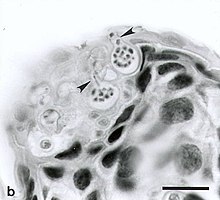Our website is made possible by displaying online advertisements to our visitors.
Please consider supporting us by disabling your ad blocker.
Chytridiomycosis


Chytridiomycosis (/kaɪˌtrɪdiəmaɪˈkoʊsɪs/ ky-TRID-ee-ə-my-KOH-sis) is an infectious disease in amphibians, caused by the chytrid fungi Batrachochytrium dendrobatidis and Batrachochytrium salamandrivorans. Chytridiomycosis has been linked to dramatic population declines or extinctions of amphibian species in western North America, Central America, South America, eastern Australia, east Africa (Tanzania),[1] and Dominica and Montserrat in the Caribbean. Much of the New World is also at risk of the disease arriving within the coming years.[2] The fungus is capable of causing sporadic deaths in some amphibian populations and 100% mortality in others. No effective measure is known for control of the disease in wild populations. Various clinical signs are seen by individuals affected by the disease. A number of options are possible for controlling this disease-causing fungus, though none has proved to be feasible on a large scale. The disease has been proposed as a contributing factor to a global decline in amphibian populations that apparently has affected about 30% of the amphibian species of the world.[3] Some research found evidence insufficient for linking chytrid fungi and chytridiomycosis to global amphibian declines,[4] but more recent research establishes a connection and attributes the spread of the disease to its transmission through international trade routes into native ecosystems.[5]
- ^ IUCN SSC Amphibian Specialist Group (2015). "Nectophrynoides asperginis". IUCN Red List of Threatened Species. 2015: e.T54837A16935685. doi:10.2305/IUCN.UK.2015-2.RLTS.T54837A16935685.en. Retrieved 12 November 2021.
- ^ Olson, Deanna H.; Aanensen, David M.; Ronnenberg, Kathryn L.; Powell, Christopher I.; Walker, Susan F.; Bielby, Jon; et al. (2013). Stajich, Jason E. (ed.). "Mapping the global emergence of Batrachochytrium dendrobatidis, the amphibian chytrid fungus". PLOS ONE. 8 (2): e56802. Bibcode:2013PLoSO...856802O. doi:10.1371/journal.pone.0056802. PMC 3584086. PMID 23463502.

- ^ Stuart, S.N.; Chanson, J.S.; et al. (2004). "Status and trends of amphibian declines and extinctions worldwide". Science. 306 (5702): 1783–1786. Bibcode:2004Sci...306.1783S. CiteSeerX 10.1.1.225.9620. doi:10.1126/science.1103538. PMID 15486254. S2CID 86238651.
- ^ Lambert, Max R.; Womack, Molly C.; Byrne, Allison Q.; Hernández-Gómez, Obed; Noss, Clay F.; Rothstein, Andrew P.; Blackburn, David C.; Collins, James P.; Crump, Martha L.; Koo, Michelle S.; Nanjappa, Priya (20 March 2020). "Comment on "Amphibian fungal panzootic causes catastrophic and ongoing loss of biodiversity"". Science. 367 (6484): eaay1838. doi:10.1126/science.aay1838. ISSN 0036-8075. PMID 32193293.
- ^ Fisher, Matthew C.; Garner, Trenton W.J. (2020). "Chytrid fungi and global amphibian declines". Nature Reviews Microbiology. 18 (6): 332–343. doi:10.1038/s41579-020-0335-x. hdl:10044/1/78596. PMID 32099078. S2CID 211266075.
Previous Page Next Page


